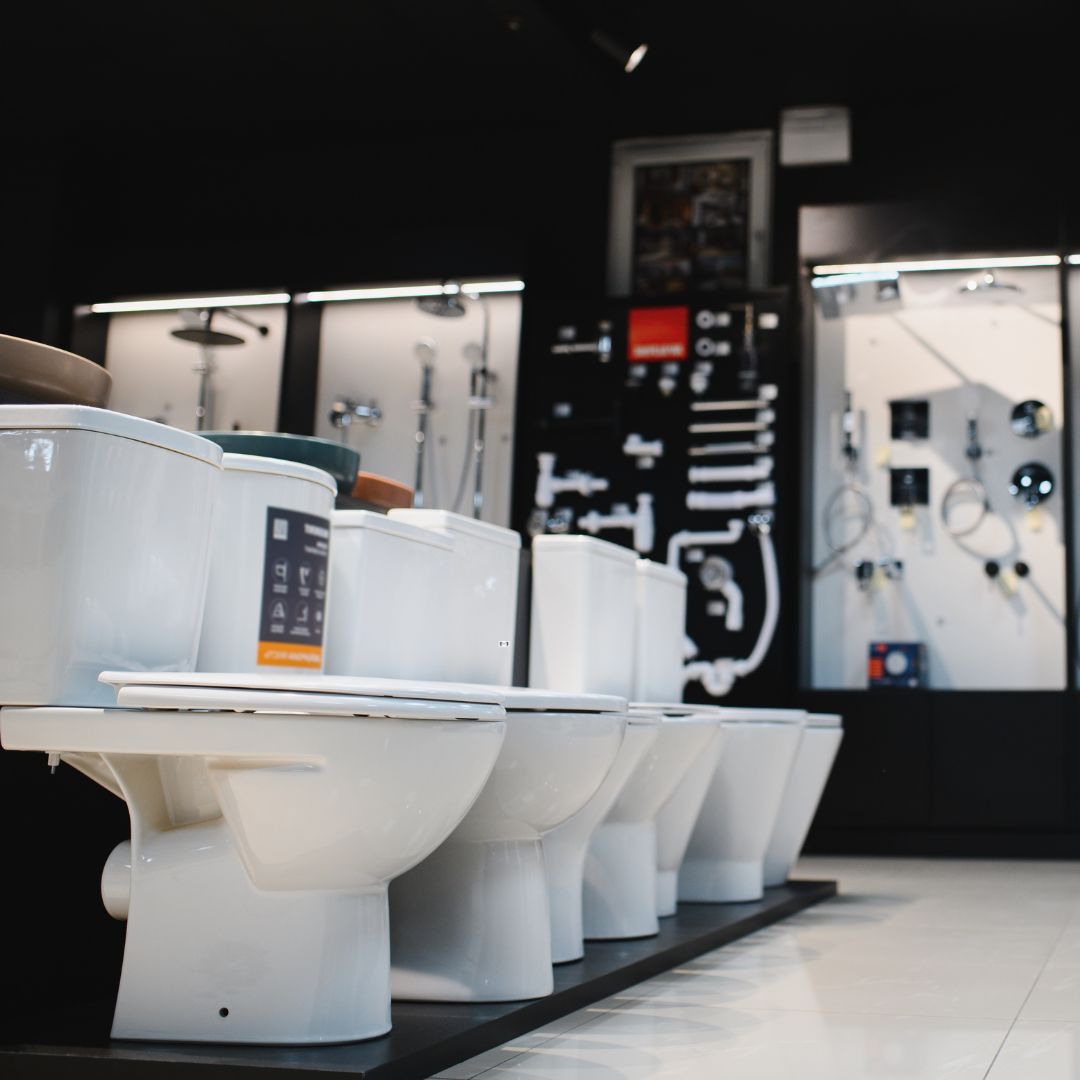Buying a new toilet sounds simple — until you start looking at all the options. The truth is, not every toilet fits every bathroom, and not all flush the same.
Before you buy, focus on five key things: know your measurements, pick what feels comfortable, choose a reliable flush, look for quality, and plan for a smooth installation.
Whether you’re shopping budget models like Glacier Bay or higher-end options like Kohler or TOTO, this guide will help you make a confident choice that fits your space, budget, and style.
🚽 Step 1: Know What You Have (and Take Measurements)
Before you go online or to a store, there are a few important measurements you’ll need to know — not all toilets are the same size or shape.
Measure Your Rough-In
The rough-in distance is the space from the wall behind the toilet to the center of the bolts that hold it to the floor.
-
Most homes use a 12-inch rough-in.
-
Some older homes have 10-inch or 14-inch rough-ins.
If you pick the wrong size, the new toilet may not fit against the wall correctly or the drain won’t line up.
Check Your Clearance
You’ll also want:
-
15 inches of space from the toilet’s center to any side wall or cabinet.
-
24 inches of open space in front so you can sit comfortably.
If you plan to upgrade from a round bowl to an elongated one, make sure you still have enough space in front of the toilet.
💺 Step 2: Pick the Right Comfort & Style
Comfort comes down to bowl shape and seat height — and both make a big difference in daily use.
Bowl shape:
-
Round bowls are compact and ideal for small bathrooms or powder rooms.
-
Elongated bowls are longer, more comfortable for adults, and usually easier to clean.
Seat height:
-
Standard height (14–15 inches) feels lower, similar to older toilets.
-
Comfort or ADA height (17–19 inches) feels more like a chair — easier on the knees and back.
If you’re not sure which you prefer, sit on both styles at a showroom in Lowe’s, Home Depot, or Menards before deciding.
💧 Step 3: Choose Your Flush System
All modern toilets save water compared to older ones, but not all flush systems work the same.
-
Gravity-fed toilets use the natural force of water to clear the bowl. They’re quiet, simple, and easy to maintain — perfect for most homes.
-
Pressure-assisted toilets add air pressure for a stronger flush, great for basements or homes with frequent clogs.
-
Dual-flush toilets give you two buttons: a low-volume flush for liquids (about 0.8–1 gallon per flush) and a higher-volume flush for solids (about 1.28–1.6 gallons).
Look for the WaterSense® label — those models meet EPA standards for water efficiency without sacrificing performance.
💡 Pro Tip: If you’re on a budget, Glacier Bay and Project Source both make excellent dual-flush options for under $150 that perform surprisingly well.
🧱 Step 4: Quality, Brands & Features
There’s a big difference between a $120 toilet and a $600 one — and it’s not just looks. Here’s what you get as you move up in price:
| Brand | Price Range | Highlights |
|---|---|---|
| Glacier Bay | $100 – $150 | Budget-friendly, easy to install, solid for rentals |
| Project Source | $130 – $180 | Great starter option for smaller spaces |
| American Standard | $200 – $400 | Strong flush performance, good warranty |
| Kohler | $300 – $600 | Stylish, durable, easy-to-find parts |
| TOTO | $500 + | Premium quality, whisper-quiet flush, long lifespan |
Material matters: choose vitreous china (porcelain with a hard enamel coating). It’s stronger and resists staining better than basic ceramic finishes.
Extra features worth considering:
-
Soft-close lid — no slamming.
-
Skirted base — hides plumbing for easier cleaning.
-
Bidet seat compatibility — adds comfort without a full remodel.
-
One-piece designs — sleeker, fewer seams to clean.
🔧 Step 5: Install It Right & Keep It Leak-Free
Even the best toilet can cause headaches if installed with old hardware. Replace these parts when installing:
-
Wax ring or wax-free seal
-
Flexible supply line (braided stainless steel lasts longest — shop toilet supply lines at any major hardware store)
-
Shut-off valve if it’s corroded or hard to turn (¼-turn compression valves are easiest to operate)
-
Bolts and washers — inexpensive and worth replacing
If you’re not comfortable setting the wax ring or lifting the toilet into place, a handyman can install it in about two hours.
Once installed, avoid harsh chemical cleaners that eat away seals. Use mild cleaners and check around the base every few months for moisture.
✅ Ready to Upgrade?
Northeast Ohio residents, if you’ve picked the right model but want it installed perfectly and guaranteed not to leak, we can help.
👉 Explore our Toilet Repair & Replacement Services to schedule a professional installation that’s built to last.
❓ Frequently Asked Questions About Buying Toilets
1. What’s the best toilet for a small bathroom?
Compact round or compact elongated models save space while keeping comfort.
2. How much does a new toilet cost?
Expect $100–$400 for most models, plus $25–$50 in installation parts. Professional installation usually runs $250–$500.
3. Are one-piece toilets better than two-piece?
One-piece toilets look sleeker and have fewer leak points, but two-piece designs are cheaper and easier to move.
4. What’s the difference between 1.6 GPF and 1.28 GPF?
GPF means “gallons per flush.” 1.28 GPF toilets save more water and are now standard for most new homes.
5. Are dual-flush toilets worth it?
Yes — they can save thousands of gallons of water per year and often lower your water bill.
6. What rough-in size do I need?
Most homes use a 12-inch rough-in, but older ones might have 10 or 14 inches. Always measure before buying.
7. Should I replace my shut-off valve when I replace the toilet?
Yes. If it’s more than a few years old or hard to turn, replace it during installation to prevent leaks.
8. Which brands are most reliable long-term?
Kohler and American Standard are known for easy-to-find parts. TOTO is top-tier for longevity and performance.
9. Can I install a toilet myself?
Yes, if you’re comfortable with basic plumbing and lifting about 80–100 pounds. If not, hire a pro — it’s fast and affordable.
10. What’s the quietest type of toilet?
Gravity-fed models are quieter than pressure-assisted ones.
11. How can I prevent toilet clogs?
Choose a model with a larger trapway (2⅛ inches or more) and avoid flushing wipes or paper towels. Learn more about what not to put down your toilet
12. Do cheap toilets clog more often?
Not necessarily. Even budget brands perform well when properly installed and vented — just avoid the absolute rock-bottom models. The problem with cheaper toilets comes down to the tank components breaking more regularly more than a clog.
13. What color options are available?
White is most common, but bone, biscuit, and black finishes are growing in popularity for modern bathrooms.
14. How long should a toilet last?
A good toilet can last 15–25 years with minimal maintenance.
15. Can I upgrade a standard toilet to a bidet later?
Yes! Most elongated bowls accept add-on bidet seats or attachments. We recommend the Hello Tushy products.

